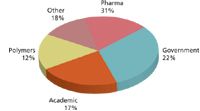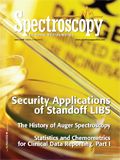Market Profile: Raman-Enabled FT-IR
Infrared (IR) spectroscopy and Raman spectroscopy are very complementary methods. The strongest demand tends to come from applications that require analytical information from a potentially broad range of compounds and functional groups. The global market for combined Raman and FT-IR accounts for a small but growing percentage of both the broader IR and Raman spectroscopy markets.
Infrared (IR) spectroscopy and Raman spectroscopy are very complementary methods. The strongest demand tends to come from applications that require analytical information from a potentially broad range of compounds and functional groups. The global market for combined Raman and FT-IR accounts for a small but growing percentage of both the broader IR and Raman spectroscopy markets.
Compounds and functional groups that give strong signatures in IR spectroscopy, such as carbonyls and nitriles, tend to be weak in Raman spectra, while the converse generally is true for aromatic compounds. While FT-IR spectroscopy has been a well-established laboratory analytical technique for some time, viable and effective Raman spectroscopy instrumentation has developed fairly recently due to the breaking of various technological barriers. Now that both techniques are fairly well established, most vendors in these areas now offer some form of combined configuration of the techniques.

Raman enabled FT-IR market demand - 2009.
Demand from the pharmaceutical industry is the largest for combined FT-IR and Raman spectroscopy because many drug formulations combine compounds and functional groups that generate strong spectra in one technique or the other. This makes combined Raman and FT-IR very useful in drug development. A significant and rapidly growing segment of this market is forensics, which is generally accounted for by government laboratories. The combination of Raman and FT-IR makes it possible to screen for a very wide range of unknown compounds, and to do so without disturbing the sample.
Most of the market for combined Raman and FT-IR consists of Raman add-on modules for FT-IR instrumentation, although fully integrated instruments are available. SDi estimates the combined global demand for these products to be around $25 million in 2009, and it should see steady high single-digit growth, even in the face of the current recession.
The foregoing data were based on SDi's market analysis and perspectives report entitled Global Assessment Report, 10th Edition: The Laboratory Life Science and Analytical Instrument Industry, September 2008. For more information, contact Stuart Press, Vice President — Strategic Analysis, Strategic Directions International, Inc., www.strategic-directions.com.

AI-Powered SERS Spectroscopy Breakthrough Boosts Safety of Medicinal Food Products
April 16th 2025A new deep learning-enhanced spectroscopic platform—SERSome—developed by researchers in China and Finland, identifies medicinal and edible homologs (MEHs) with 98% accuracy. This innovation could revolutionize safety and quality control in the growing MEH market.
New Raman Spectroscopy Method Enhances Real-Time Monitoring Across Fermentation Processes
April 15th 2025Researchers at Delft University of Technology have developed a novel method using single compound spectra to enhance the transferability and accuracy of Raman spectroscopy models for real-time fermentation monitoring.